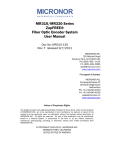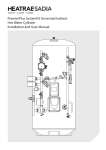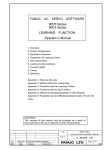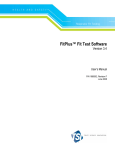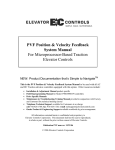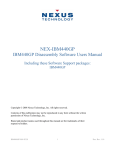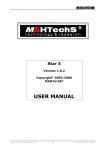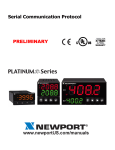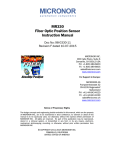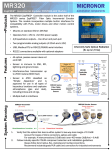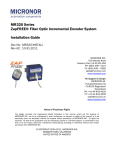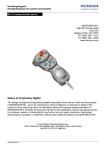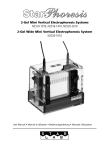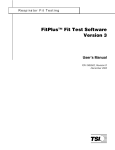Download MR330 Instruction Manual
Transcript
MR302-2 Fiber Optic Incremental Encoder OEM PCB Controller Instruction Manual DOC: 98-0302-200 MICRONOR INC. 900 Calle Plano, Unit K Camarillo, CA 93012 USA T +1-805-389-6600 F +1-805-389-6605 [email protected] www.micronor.com For Support in Europe: MICRONOR AG Pumpwerkstrasse 32 CH-8105 Regensdorf Switzerland T +41-44-843-4020 F +41-44-843-4039 [email protected] www.micronor.com Notice of Proprietary Rights The design concepts and engineering details embodied in this manual, which are the property of MICRONOR INC., are to be maintained in strict confidence; no element or detail of this manual is to be spuriously used, nor disclosed, without the express written permission of MICRONOR INC. All rights are reserved. No part of this publication may be reproduced, stored in a retrieval system, or transmitted in any form or by any means, electronic, mechanical, photocopying, recording, or otherwise, without prior written permission from MICRONOR INC. © COPYRIGHT 2014-2015, MICRONOR INC. CAMARILLO, CALIFORNIA UNITED STATES OF AMERICA MICRONOR INC. MR302-2 OEM PCB Controller Document 98-0302-200 Revision History REV A B C D E Date Notes 8/11/2014 Initial Release 8/21/2014 Updated to reflect changes made to the PCB. Namely a new connector and updated serial interface to RS485/RS422. 2/6/2015 Changed Modbus address from 0x800 to 0x400 reading model number. Updated section 3.8 Corrected pin number to 15 Corrected the description to table for cmd 0x208 6/1/2015 General update and reformatting Updated Specifications Updated ZAPPY® software section with interface examples 9/16/2015 Updated with new Camarillo address and telephone/fax numbers Page 2 of 57 MICRONOR INC. MR302-2 OEM PCB Controller Table of Contents 1. Product Description ............................................................................................. 5 1.1 1.2 2. Initial Preparation ................................................................................................. 7 2.1 2.2 2.3 3. Incremental Encoder Background .................................................................. 5 Fiber Optic Incremental Sensor ..................................................................... 5 Unpacking and Inspection ............................................................................. 7 Damage in Shipment ..................................................................................... 7 Standard Contents ......................................................................................... 7 Installation and Operation .................................................................................... 8 3.1 Mounting the Sensor Unit .............................................................................. 8 3.2 Mounting the MR302-2 Controller PCB ......................................................... 9 3.3 Optical Connections to the MR302-2 Controller ............................................ 9 3.4 Electrical Connections To MR302-2 Controller ............................................ 10 3.5 Interfacing with a Motor Servo Drive............................................................ 12 3.6 Film Mounting/Film Handling When Using MR303 ...................................... 13 3.7 Initial Optical Power Level Referencing when using Film ............................. 15 3.8 Power-up or Periodic Optical Sensitivity Calibration .................................... 16 3.8.1 Optical sensistivity calibration for linear sensors ................................... 16 3.8.2 Optical sensititivty calibration for rotary sensors ................................... 16 3.9 Indexing for Linear Absolute Position .......................................................... 17 3.10 Initial System Configuration and Power-Up Examples .............................. 18 3.10.1 Rotary Encoder Configuration and Operation....................................... 18 3.10.2 Linear Encoder With Film And Using HOMING Function ...................... 20 3.10.3 Linear Encoder With Film Without HOMING Region ............................ 22 4. Modbus Serial Communications ......................................................................... 24 4.1 Modbus Serial Interface ............................................................................... 24 4.2 MODBUS Communications Protocol ........................................................... 26 4.3 Error Handling and Troubleshooting ........................................................... 34 4.3.1 Explanation of Status and Error Handling ............................................. 34 4.3.2 Explanation of Status and Error Indication ............................................ 34 4.3.3 Reading The Error Counters ................................................................. 39 5. Warranty Information.......................................................................................... 40 6. Specifications ..................................................................................................... 41 6.1 6.2 6.3 7. MR302-2 OEM PCB Controller .................................................................... 41 MR303 Linear Sensor ................................................................................... 42 MR304 Rotary Sensor................................................................................... 43 ZAPPY® 302 SOFTWARE ................................................................................... 44 Page 3 of 57 MICRONOR INC. MR302-2 OEM PCB Controller 7.1 How To Install and Use Zappy® 302 ............................................................ 44 7.2 ZAPPY® Menu Screens ................................................................................ 44 7.2.1 System Functions screen....................................................................... 44 7.2.2 User Functions screen ........................................................................... 46 7.2.3 Service Functions screen....................................................................... 47 7.2.4 Command List screen ........................................................................... 48 7.3 USB-to-RS422/485 Interface Examples ........................................................ 49 7.3.1 Full Duplex Modbus/RS485 Communications using USB Converter ..... 49 7.3.2 Half Duplex Modbus/RS485 Communications using USB Converter..... 51 7.3.3 How To Power MR302-2 Controller from USB ...................................... 55 8. MR302 Theory of Operation............................................................................... 56 8.1 MR302-2 PCB Controller.............................................................................. 56 Figures Figure 1. Controller works with both MR303 Linear and MR304 Rotary Encoders....... 8 Figure 2. Keep LC Duplex connector ends protected when not in use ....................... 8 Figure 3. Dimensions of MR302-2 Controller PCB ...................................................... 9 Figure 4. Positioning film inside MR303 sensor ......................................................... 13 Figure 5. The emulsion side is up when right side reading text ................................ 13 Figure 6. Filmstrip dimensions .................................................................................. 14 Figure 7. Location of pushbutton for initial optical level calibration .......................... 15 Figure 8. ZAPPY® System Functions screen.............................................................. 45 Figure 9. ZAPPY® User Functions screen .................................................................. 46 Figure 10. ZAPPY® Service Functions screen............................................................ 47 Figure 11. ZAPPY® Command List screen ................................................................ 48 Figure 12. Full Duplex Test Setup using USB-to-RS485 Converter ............................ 49 Figure 13. Half Duplex Test Setup using USB-to-RS485 Converter ........................... 51 Figure 14. Communicating with multiple MR302-2 Controllers ................................. 53 Figure 15. Block Diagram of MR302-2 Controller ..................................................... 56 Page 4 of 57 MICRONOR INC. 1. Product Description 1.1 Incremental Encoder Background MR302-2 OEM PCB Controller Incremental encoders are typically used to sense the motion and speed of a motor shaft. Typically the encoder outputs two phase-shifted signals. Depending on the direction of movement, the phase shift is either +90° or -90°, this signal is referred to as the Quadrature Signal. Typically these encoders incorporate electronics and are susceptible to electrical interferences (EMI/RFI). Examples include: • Pipe and tube welding produces extreme interference while the welding process is active • MRI machines operate under an extremely strong electromagnetic field • Surgical robots must perform 100% reliably • Aerospace actuators operate in and around other noise generating avionics An all-optical, non-electronic passive solution such as the fiber optic encoder provides completely immunity to such interferences. 1.2 Fiber Optic Incremental Sensor The MR302 series fiber optic position sensor system is an innovative all-optical design immune to any electro-magnetic interference such as lightning, radiation, magnetic fields and other harsh environmental conditions. The fiber optic aspect of the sensor also makes it perfectly suited for long distance speed and position sensing over hundreds of meters without being affected by ground loop problems. This innovative product can be fitted to an existing DC motor or it is available as a stand-alone encoder. Page 5 of 57 MICRONOR INC. MR302-2 OEM PCB Controller The controller board sends two separate optical wavelength signals to the encoder. The encoder then modulates each optical beam based on the direction with a leading or lagging phase shift. µProcessor 850nm 980nm VCSEL Driver Status Gain/Offset 850nm Amplifier A 980nm Amplifier B RST VCSEL CTRL Serial Signal Detection A B The return optical signals are split up into two separate beams and converted back into an electrical signal. A microprocessor is used to supervise the amplitude of the optical signals and constantly adjust the signal as to provide a stable quadrature output. The microprocessor has built-in error checking and will signal any anomaly within the operation of the sensor system Page 6 of 57 MICRONOR INC. 2. Initial Preparation 2.1 Unpacking and Inspection MR302-2 OEM PCB Controller The unit was carefully inspected mechanically and electrically before shipment. When received, the shipping carton should contain the following items listed below. Account for and inspect each item before the carton is discarded. In the event of a damaged instrument, write or call your nearest MICRONOR sales office. Please retain the shipping container in case re-shipment is required for any reason. 2.2 Damage in Shipment If you receive a damaged instrument you should: 1) 2) 3) Report the damage to your shipper immediately. Inform MICRONOR Save all shipping cartons. Failure to follow this procedure may affect your claim for compensation. 2.3 Standard Contents MR302 Sensor: • MR302 series sensor with fiber cable length as ordered and terminated with Duplex LC connector. Examples: MR303, MR304, etc. • Instruction Manual (this document, one soft copy supplied with each shipment) MR302-2 Controller PCB: • MR302-2 Controller OEM PCB • Instruction Manual (this document, one soft copy supplied with each shipment) Both this Instruction Manual and ZAPPY® 302 software can also be download from www.micronor.com Page 7 of 57 MICRONOR INC. 3. Installation and Operation 3.1 Mounting the Sensor Unit MR302-2 OEM PCB Controller Various different types of sensors will work in conjunction with the MR302-2 Controller. MR302 series Rotary Encoder offers small size and resolution up to 512ppr. The MR303 Linear Encoder is a special read-head sensor that can be used to measure linear movement. It is constructed of both non-metallic and non-ferrous materials. The sensor is safe for use within or around MRI equipment, or within other extreme electromagnetic fields. Figure 1. Controller works with both MR303 Linear and MR304 Rotary Encoders When installing the sensor, be careful not to bend the fiber excessively. It is recommended to keep the minimum bend radius 25mm (1”) or larger. Ensure the fiber outlet at the encoder is protected from excessive pulling or bending. Figure 2. Keep LC Duplex connector ends protected when not in use Make sure fiber optic connector tips are always covered when not in use. Always clean and inspect the connector ends before mating to interface. Page 8 of 57 MICRONOR INC. MR302-2 OEM PCB Controller Be sure to use proper fiber optic cleaming tools and procedures such as the Micronor MR321C Cleaning Kit. Improper tools and/or processes may damage or contaminate the optical interface. 3.2 Mounting the MR302-2 Controller PCB The controller PCB should be mounted on 4 standoffs. Plenty of room should be left for access to the Fiber Optic Interface. The mounting holes are suitable for #2-56 or M2.5 screws. The mounting holes are electrically connected to GND. Consult Reference Drawing 98-0302-30 for more information Figure 3. Dimensions of MR302-2 Controller PCB 3.3 Optical Connections to the MR302-2 Controller A duplex fiber optic cable is used to interconnect the sensor and controller. The sensor incorporates a 1.5m optical pigtail (or as specified by customer). If a longer connection to the controller is required then an extension fiber cable having duplex LC connector may be used. Remove the dust cap form both the connector on the cable and the receptacle on the controller. Insert the LC connector as shown. There should be a positive click when the connector is engaged properly. Do not force the Fiber Optic Connector! Page 9 of 57 MICRONOR INC. 3.4 MR302-2 OEM PCB Controller Electrical Connections To MR302-2 Controller The unit is powered by 5V DC with maximum 100mA current consumption. Encoder signals are 5V RS422 Line Driver compatible. Serial Interface is Modbus RS485/RS422 compatible. Default baud-rate 57600, 8bit, 1 stop, no parity Default address 235 Ribbon Connector 16 pin: 3M PN: N2516-5002-RB (Right Angle on PCB) Mating Part suggestion: 3M PN: 89116-0103 Function PIN PIN Function n/c 1 2 +5V Power Supply GND 3 4 n/c ENC A5 6 ENC A+ ENC B7 8 ENC B+ +5V Power Supply 9 10 GND (Serial) RCV11 12 RCV+ (Serial) (Serial) XMT13 14 XMT+ (Serial) ZERO INP 15 16 STATUS OUT (5V) Ribbon Cable: 16 conductor 0.050” pitch 3M P/N 3302/16 300SF (Digikey P/N MC16M-10-ND) NOTE: Mounting holes are internally connected to GND. Page 10 of 57 MICRONOR INC. MR302-2 OEM PCB Controller When all connections are made, than apply 5VDC electrical power to the controller PCB. There are 4 indicator LED’s on the PCB. The channel A & B indicator LED’s are ON when the respective quadrature signal is high. When the encoder is moving, these LEDs will effectively blink. The STATUS LED is ON when the encoder is turning. The Power LED is ON and is steady state when the system is working properly. It indicates abnormal status using blink codes. Blinks Steady ON 1 2 3 4 5 Code Description System is OK Optical Power is too high. This is only possible when the transmitter experienced a problem. It may be possible to correct the situation by adjusting the VCSEL power using the ZAPPY® software. Low optical power. When this appears, first rotate the encoder and check if the problem continues. If yes, check all optical connections. Most of the time a low power indication is the result of contaminated or bad connectors. If a very long fiber optic link is used, then the user may increase the optical power by following the initializing the power levels as described in section 3.7. (Hold down the button for 10seconds) Sensor is disconnected. Broken optical link. 5V input power is outside safe range. Internal low voltage on the 3.3V power supply. Note: The status output on J1-16 is high whenever an abnormal condition is indicated. Note: There are more status conditions which are listed in Section 4.3 Error Handling. In general, any status indication is also available via serial interface. Page 11 of 57 MICRONOR INC. 3.5 MR302-2 OEM PCB Controller Interfacing with a Motor Servo Drive One common application for any encoder is to provide position and velocity information to a servo drive. To simplify the connection task, the ribbon connector pin-out of the MR302-2 Controller board is designed to directly interface with the Maxon EPOS2/24 controller. The 5V power is derived from the EPPOS drive and the A & B line driver signals are routed from the MR302-2 controller directly to the EPOS drive on connector J3. The pins for the motor voltage output are not connected on the MR302-2 Controller PCB and thus do need to be isolated. Motor Power DC Motor With Integrated MR302 Encoder Fiber Optic MR302-2 Controller 1 Encoder 4 16 1 15 9 J1 J3 J14 13 MAXON EPOS2/24 12 24V Power Supply Computer Optionally, the STATUS OUT output and ZERO INP input can be connected to the universal digital in/out of the EPOS drive. This allows the encoder STATUS output to be read into the host computer and analyzed. For automatic optical calibration, the ZERO input can be activated by outputting a logic high on the respective EPOS digital output. A typical start-up procedure would be to let DC Motor run in current mode without feedback, and then, raise Pin 15 for ~100ms. That will initiate an optical calibration cycle. Page 12 of 57 MICRONOR INC. MR302-2 OEM PCB Controller Although it is possible to read speed and position directly from the MR302-2 Controller during normal operation, this may not be necessary if the encoder information can be read directly via the servo drive system (such as Maxon EPOS23/24). 3.6 Film Mounting/Film Handling When Using MR303 Although the film positioning within the sensor slit is not critical, it should be mounted in such a way that it is as parallel to the sensor pick-up head as possible. Ideally the film should be mounted so it is perpendicular to the sensor head and always lay against one side of the slit. The film should be prevented from wobbling within the slit. Emulsion side of film must face side where the fiber enters the sensor. Be careful when handling film to not leave fingerprints. After film strip is inserted into sensor, either use the supplied clip or cover to secure film and maintain proper alignment. Figure 4. Positioning film inside MR303 sensor Figure 5. The emulsion side is up when right side reading text To protect the film from scratches where the light senses the lines, the assembly has a slight recess. It is therefore important that the film is operated sliding at the bottom of the assembly. Page 13 of 57 MICRONOR INC. MR302-2 OEM PCB Controller The high precision optical read head is very high precision and is sensitive to scratches or dust on the film. Scratches of 50µm or more can cause an erroneous pulse. Positioning the film affects the ultimate performance of the system. Apply just enough pull to the film so as it is stretched at all times. Too much pull will increase pressure on the read surface and may lead to high wear of the film. Typically 50-100 grams of pull force is sufficient. When using a film with 0.4mm line spacing, it is posible to obtain 0.1mm resolution. Consult Figure 6 below for recommended film strip dimensions. Each opaque and translucent cycle will need to be a total of 400µm. 400µm 850nm 980nm 100µm Figure 6. Filmstrip dimensions As can be seen in Figure 6, positional accuracy is given by the film itself and the shape of the light beam. The film is made accurately to within ±3µm. The absolute edge accuracy is approx. ±25% of the slit width. With the design, as shown above, the very worst case deviation is ±50µm maximum. Typically ±25µm can be expected. Thermal expansion of the film tape is typically 22µm/m/°C. With the temperature variation within an MRI environment being minimal, this deviation is not a factor in accuracy when operating at normal room temperature. The film base material is highly stable. Page 14 of 57 MICRONOR INC. MR302-2 OEM PCB Controller To obtain a balanced signal with a duty cycle of 50% and a phase shift of 90°, the distance from the optical fiber to the film must be accurately controlled within the pick-up assembly. This is a factory-only adjustment. 3.7 Initial Optical Power Level Referencing when using Film After initial installation, it is important that the optical power levels (one level for each quadrature channel) are calibrated to the nominal operating level. This is required to compensate for fiber optic connector losses and variation between sensors and controllers. The MR302-2 controller is designed to perform this calibration procedure automatically once initiated by the user. • • • Install the sensor, film, the controller and make all fiber connections. Set the sensor to a clear area of the film where there are no obstructions. Press the “CAL” button on the controller for 10 seconds. The PWR LED will blink while the calibration is being performed. After ~10 seconds, the STATUS LED will blink shortly, then release the button. Left Home Position -382 Working Area Center Position = 0 -382, -381, -380 +380, +381, +382 Right Home Position +382 Pick-Up The internal procedure within the controller is as follows: The input amplifiers are being set to a known sensitivity (gain), then the laser power for each channel is adjusted until the desired internal voltage level (2V) is reached. The new power setting values are saved in EEPROM. This is the only procedure that will alter the laser power levels. During normal operation, only the input amplifier gain is adjusted for maintaining proper voltage levels. NOTE: This calibration sequence may also be initiated via Modbus command. Figure 7. Location of pushbutton for initial optical level calibration Page 15 of 57 MICRONOR INC. 3.8 MR302-2 OEM PCB Controller Power-up or Periodic Optical Sensitivity Calibration As part of the normal power-up procedure, it is possible to perform an optical power calibration. This is useful so that the system immediately starts counting with the highest accuracy. The external ZERO input (J1-Pin 15) of the controller is configured in such a way that when a +5V signal is applied to this input, the internal counter is Reset to the Preset value stored in Register 0x209. If so configured as described herein, the input amplifier level calibration may be initiated at the same time. 3.8.1 Optical sensistivity calibration for linear sensors At power up, it is recommended to move the MR303 sensor head to a clear area of the film strip and then initiate a +5V logic pulse of ~100ms to 1sec duration to the Zero input (J1-Pin 15). Instead of a +5V logic pulse on J1-15, the sequence may be initiated using Modbus FC05 0x007. Register 0x208 must be configured to 0x03 in order for the above procedure to work properly. This procedure can also be repeated at periodic interval or during self-test cycles. 3.8.2 Optical sensititivty calibration for rotary sensors For MR30X series rotary sensors, optical sensitivity calibration is performed in real-time when the encoder is rotating. The controller monitors the signal lows and highs and sets the internal gain accordingly. Therefore, no special calibration procedure is required for rotary sensor. Page 16 of 57 MICRONOR INC. 3.9 MR302-2 OEM PCB Controller Indexing for Linear Absolute Position The MR303 linear sensor system is an incremental encoder and will not know the absolute position when the unit is powered up. Generally, an index point must be provided to obtain absolute position. Since the MR303 fiber optic sensor works different from standard encoders, it is possible to reserve a “homing” area on the film strip. Outside the actual work area, the film is left transparent without alternating lines. After the robot powers up, the servo system must drive the sensor head either left or right to the clear “homing” area until encoder pulses are no longer received. Tthe desired Preset reference count, corresponding to the absolute known position to the start of the first line, is loaded into the position counter. The servo motor then drives towards the start of the working area. The position counter will start counting as soon as the first line is encountered. Left Home Position -382 Working Area Center Position = 0 -382, -381, -380 +380, +381, +382 Right Home Position +382 Pick-Up Note: The number examples above are when x2 multiplier is used. The left and right homing positions are provided to the servo control system as part of an initial factory calibration cycle. Whenever there is opportunity to position the sensor to an area outside the working area and perform a “homing” procedure, the above described scheme is elegant and does not add complexity or cost to the system. This procedure can also be combined with an optical input sensitivity calibration sequence per Section 3.8. Page 17 of 57 MICRONOR INC. MR302-2 OEM PCB Controller 3.10 Initial System Configuration and Power-Up Examples This section provides examples on how the encoder system can be initially configured and operated. The three scenarios described are: • Rotary encoder • Linear Encoder using Film With HOMING Region • Linear Encoder using Filem without HOMING Region Micronor supplies ZAPPY® 302 software free-of-charge to MR30X users. The software is designed for configuring and troubleshooting an MR30X rotary or linear encoder system. The ZAPPY® screens and command buttons emulate the Modbus commands so that the user can become familiar with configuring and operating the system. For detailed information about specific Modbus commands, consult Section 7. 3.10.1 Rotary Encoder Configuration and Operation Hardware Example: MR304 Rotary Encoder and MR302-2 Controller For Rotary Applications Using Quadrature Outputs Only For systems that will use the A/B quadrature outputs only, the user need only optically connect the encoder to the controller and go. Optical Signal Calibration occurs automatically while the encoder is turning. Before initial use, it is recommended to connect the optical link (all segments, full length) first and perform an Optical Signal Calibration. This is to make sure that the optical link loss bidget is within specifications. Initial Configuration Sequence Rotary Encoder using Quadrature Outputs Only Step Action Notes Connect encoder and controller with final optical link connected (all 1 Connect 2 Optical Calibration 3 Ready To Use Page 18 of 57 segments). Perform an Optical Signal Calibration by simultaneously rotating the encoder and holding down the on-board Calibration pushbutton for at least 10 seconds. The POWER LED will blink while calibration is performed. After 10 seconds,the STATUS LED will blink shortly indicating that calibration is complete and the user can then release the button. MICRONOR INC. MR302-2 OEM PCB Controller Power-Up Sequence Rotary Encoder using Quadrature Outputs Only Step Action Notes 1 System ready to operate For Rotary Speed/Position Sensing Applications Using Modbus Interface Many integrated OEM systems will want to take advantage of the embedded functions within the MR302-2 controller for reading rotary encoder speed and position via the Modbus interface. This frees the controller or PLC from tracking these parameters themselves via the quadrature outputs. Initial Configuration Sequence Rotary Encoder using Modbus communincations Step Command Name Register Address Notes Set to 1 to reset Position Counter to the Preset 1 Reset Mode FC10 0x208 Value. For the Position Counter to function properly, the user’s actuator will need to be in the desired reference position when the ZERO Input is pulsed. This will be the Position Counter value when the user’s actuator system is in the reference position. Typically the user will set this value to 0 unless another initial setting is required. 2 Preset Value FC10 0x20A 3 FC10 0x211 Set to 0 for 2 counts per line Set to 1 for 4 counts per line 4 Quadrature Multiplier Direction FC10 0x20B 5 Speed Filter FC10 0x216 6 Save To EEPROM FC05 0x002 With this command, the user can set the preferred direction and “polarity” of the Position Counter. Set to 0=CW or 1=CCW. For applications monitoring Speed via Modbus, the user may want to select a value (0-8) to filter speed results. Send this command to save all current parameters to internal EEPROM Power-Up Sequence Rotary Encoder using Modbus communications Step Command Name Action Notes 1 User actuator system is at initial reference position. 2 ZERO Input Pulse ZERO Input With Reset Mode 0x208 set to 1, the controller will reset Position Counter to the Preset Value. or send FC05 0x007 command ZERO Input may also be a homing switch. 3 System ready. Read Position Count and Speed via Modbus Page 19 of 57 MICRONOR INC. MR302-2 OEM PCB Controller 3.10.2 Linear Encoder With Film And Using HOMING Function Hardware Example: MR303 Linear Encoder, MR302-2 Controller and TD5334 series Film Strip with 1 or 2 HOMING regions. The diagram below illustrates an application employing a Film Strip with HOMING region on both sides. Left HOMING Region Known Home Position Working Area Right HOMING Region Sensor Section 3.9 described how to using the HOME technique as an Index for absolute position monitoring. This type of application would then use the Modbus interface to read absolute position and speed status. The quadrature outputs can also be used independently. The following tables describe how to initially configure and operate the MR303 system in this scenario. Initial Configuration Sequence HOMING Linear Encoder Configuration Step Command Name Register Address 1 Reset Mode FC10 0x208 2 Preset Value FC10 0x20A 3 FC10 0x211 4 Quadrature Multiplier Direction 5 Speed Filter FC10 0x216 6 Save To EEPROM FC05 0x002 Page 20 of 57 FC10 0x20B Notes Set to 3 to perform both an Optical Signal Calibration and reset Position Counter at the same time. For the Position Counter to function properly, the user’s actuator will need to be in the “Homing” zone when the ZERO Input is pulsed. This will be the Position Counter’s initial value when the user’s actuator system moves out of the HOMING region and encounters the first line on the Encoder Film Strip. Typically user will set this value to 0 unless another intial setting is required. Set to 0 for 2 counts per line Set to 1 for 4 counts per line With this command, the user can set the preferred direction and “polarity” of the Position Counter. Set to 0=CW or 1=CCW. For applications monitoring Speed via Modbus, the user may want to select a value (0-8) to filter speed results. Send this command to save all current parameters to internal EEPROM MICRONOR INC. MR302-2 OEM PCB Controller Example: To perform the optical calibration using the external pin and set the counter to a predefined value, and set the turn direction to 1 t the initial setup should be as follows: Register 0x0001 “xxxx” Counter Register may be any value Register 0x0208 “3” Reset Mode Register 0x0209 “250” Preset Register. This value will be in the counter after the reset Register 0x020B “1” Turn or Count Direction Execute FC05-2 to save the parameters in EEPROM After a normal power up, all is required to drive the sensor to the transparent area of the film and pulse the External Homing input. Register 0x0001 Register 0x0208 Register 0x0209 Register 0x020B Note: “250” “3” “250” “1” Counter Register is now set at 250 Reset Mode Preset Register. This value will be in the counter after the reset Turn or Count Direction Executing the calibration will automatically save all current parameter register content to EEPROM. Normal Power-Up Sequence HOMING Linear Encoder Step Command Name Action Notes 1 User actuator system within HOMING region. 2 ZERO Input Pulse ZERO Input With Reset Mode 0x209=3, controller will perform Optical Signal Calibration and reset or send FC05 Position Counter to the Preset Value. 0x007 command 3 System ready. Read Position Count and Speed via Modbus. It is recommended to initiate the aabove procedure at any time that the sensor is known to be in the HOMING region. Quadrature outputs can also be used independently. Page 21 of 57 MICRONOR INC. MR302-2 OEM PCB Controller 3.10.3 Linear Encoder With Film Without HOMING Region Hardware Example: MR303 Linear Encoder, MR302-2 Controller and TD5334 series Film Strip without HOMING region. The diagram below illustrates an application employing a Film Strip without any HOMING region. Sensor In this section, the MR303 linear encoder uses an Encoder Film Strip without a HOMING region. That is, the Encoder Film Strip is a sequence of lines only. A typical application will use the Modbus interface to track position and speed. The quadrature outputs can also be used independently. The following tables describe how to initially configure and operate the MR303 system in this scenario. Initial Configuration Sequence Non-HOMING Linear Encoder Step Command Name Register Address 1 Reset Mode FC10 0x208 Notes Set to 1 to reset Position Counter only. For the Position Counter to function properly, user’s actuator must be at the reference position when ZERO Input is pulsed. This will be the Position Counter value when the actuator is at the reference position. Typically, the user will set this value to 0 unless another initial setting is required. 2 Preset Value FC10 0x20A 3 FC10 0x211 Set to 0 for 2 counts per line Set to 1 for 4 counts per line 4 Quadrature Multiplier Direction FC10 0x20B 5 Speed Filter FC10 0x216 6 Save To EEPROM FC05 0x002 7 Optical Calibration With this command, the user can set the preferred direction of the Position Counter. Set to 0=CW or 1=CCW. For applications monitoring Speed via Modbus, the user may want to select a value (0-8) to filter speed results. Send this command to save all current parameters to internal EEPROM Perform an Optical Signal Calibration by simultaneously moving the Encoder Film Strip back and forth while holding down the onboard Calibration pushbutton for at least 10 seconds. The POWER LED will blink while calibration is performed. After 10 seconds,the STATUS LED will blink shortly indicating that calibration is complete and the user can then release the button. Page 22 of 57 MICRONOR INC. MR302-2 OEM PCB Controller Power-Up Sequence Non-HOMING Linear Encoder Step Command Name Action Notes 1 User actuator system is at initial reference position. 2 ZERO Input Pulse ZERO Input Controller will reset Position Counter to the Preset Value. or send FC05 0x007 command 3 System ready. Read Position Count and Speed via Modbus Quadrature outputs can also be used independently. 4 An automatic Optical Calibration is performed whenever the sensor sweeps through the active area at minimum speed of 0.2 meters/second. Page 23 of 57 MICRONOR INC. 4. Modbus Serial Communications 4.1 Modbus Serial Interface MR302-2 OEM PCB Controller The main purpose of the Modbus-compatible serial interface is to query the MR302-2 controller for status, position and speed while in operation. The serial interface is also used to configure the controller unit as well as system troubleshooting. MICRONOR supplies the ZAPPY® software to access these functions via the serial interface of your PC (Personal Computer) computer. Serial Interface Specification (default) • • • • • • Serial with logic levels full duplex. Baudrate programmable: 57,600 baud 1 Start Bit 8 Data Bits 1 Stop Bit no parity The protocol is Modbus compatible and thus the protocol includes a node address. That is so that the PCB could be integrated into larger systems using a number of Modbus slaves. Factory Standard ModBus Address is set to 235 (Hexadecimal 0xEB). Note: The MR302-2 OEM PCB requires a RS485/422-to-RS232 adaptor or RS485/422-to-USB adaptor for communicating with a computer. Note: The MR302-2 OEM Controller uses the 235 address as the common call address. It will always respond to address 235. Pull-Up/Pull-Down Resistors Since the bus lines will go idle and into an undefined state when inactive, it is important that the lines are pulled-up and pulled-down respectively when inactive. The pull-up / pull-down resistor are typically at the master. Consult following Modbus circuit definitions. Page 24 of 57 MICRONOR INC. MR302-2 OEM PCB Controller 2-Wire Circuit Half Duplex D1 (RX+ / TX+) is pulled up to +5V D0 (RX- / TX-) is pulled down to GND Recommended resistor is 1KΩ 4-Wire Circuit Full Duplex TXD1 (TX+) and RXD1 (Rx+) are pulled up to +5V TXD0 (TX-) and RXD0 (RX-) are pulled down to GND Recommended resistor is 1KΩ Page 25 of 57 MICRONOR INC. 4.2 MR302-2 OEM PCB Controller MODBUS Communications Protocol The communications protocol follows the Modbus RTU (binary) protocol. A number of commands allow for configuring the operational parameters of the MR302 while other commands are specifically meant for diagnostics used during setup, maintenance and troubleshooting. The status and position readout registers are intentionally arranged in sequence for a quick readout while system is in operation mode. The format for the commands and responses in general follow the MODBUS RTU specification, with the exception that not all registers maybe combined within one readout sequence. See table below for allowable register combination. Modbus information can be obtained at www.modbus.com What Is ZAPPY® Setup Software? Zappy® 302 is a setup program provided free-of-charge with the purchase of the MR302 system. ZAPPY® runs on Windows XP, Vista, Windows 7, Windows 8 and requires .net Framework 4.0 to be on the machine. Please refer to section 7 for detailed information. Unless you plan to connect the MR302 to your own PLC or computer equipment for real-time data retrieval, you do not need to become familiar with the detailed communications protocol described herein. Framing Message frames are separated by a silent interval of at least 3.5 character times. If a silent interval of more than 1.5 character times occurs between two characters of the message frame, the message frame is considered incomplete and is discarded. A 16bit LRC/CRC Frame Check follows the message. Device Address Selection The MR302 comes pre-configured with Device address 235 (Broadcast address). The MR302 always listens to address 235 (Broadcast Address). To re-program the device address, send desired new address via command FC10 to register 0x104 via the broadcast address (235) and then send the appropriate “STORE EEPROM” command via FC52 register Upon that procedure the unit will listen to both the newly assigned Device Address and the Broadcast address 235. Register Numbers versus Meter Addresses In this instruction manual, all registers are referred to by their address, i.e. starting at 0. Page 26 of 57 MICRONOR INC. MR302-2 OEM PCB Controller Some Master devices (e.g., Modicon) require that the desired Register Number and not the Register Address be entered. The Register Number is 1 higher than the Register Address. For entry to these devices, add 1 to the Register Address shown in the tables below. The Register Address shown will then be output from these devices. FUNCTION FC03 – Read Holding Registers FUNCTION FC10 – Write Holding Registers Holding registers FC03 are used for reading the position and all other parameters These Registers can be written using Function FC10 using identical address offset Be cautious of using the Operating Mode 0x105 register command. Do not put unit in any of these modes without first consulting the user manual. Be familiar with what these functions before using. Register Address 0x000 Register Number 0x001 Name # regs 1 Range Description n/a Get Encoder Count Get Speed 2 n/a 2 n/a Returns the system status. A 0x0000 means all is ok. See status information. Returns or sets position count as a 32bit integer. Returns the speed information as a 32 –bit signed in 1/100 rpm. 0x001 0x002 0x003 0x004 0x004 0x040 0x005 0x041 2 18 n/a n/a 0x101 reserved Get Error Counts reserved 0x100 2 0MaxCount 0x104 0x105 Device Address 1 1 – 254 0x105 0x106 Operating Mode 1 0, 2 Page 27 of 57 System Status Returns 18 registers with the total number of errors for each error class. Sets the MR302 serial address for commands. Note that the address 4 cannot be used. A FC06 command to save EEPROM must be issued following this command. Used to setting MR302 in calibration, or troubleshooting mode. Normal Operating is 0. Debug mode is 2. Do not put unit in any of these modes without first consulting the user manual. Be familiar with what these functions before using. MICRONOR INC. MR302-2 OEM PCB Controller 0x130 0x131 CHA Amplitude minimum 1 n/a 0x131 0x132 CHA Amplitude maximum 1 n/a 0x132 0x133 1 -128 – 127 0x133 0x134 1 -128 – 127 0x134 0x135 1 --128 – 127 Factory use only – do NOT write to it. Hardware calibration value for voltage output 0x135 0x136 1 -128 – 127 0x136 0x137 Voltage Offset Factory Calibration Voltage Gain Pos Factory Calibration Voltage Gain Neg Factory Calibration Current Gain Factory Calibration CHB Amplitude minimum 1 n/a 0x137 0x138 CHB Amplitude maximum 1 n/a Factory use only – do NOT write to it. Hardware calibration value for current output Outputs the minimum observed amplitude of the optical signal. Generally this signal is less than 15 counts because the optical signal should swing from 0 to 640counts. (0V to 2V). Of course the encoder must be turning otherwise the signal can be anything from 0 to +640. Outputs the maximum observed amplitude of the optical signal. Generally this signal is approximately 640 counts because the optical signal should swing from 0 to 640counts. (0V to 2V). Page 28 of 57 Outputs the minimum observed amplitude of the optical signal. Generally this signal is less than 15 counts because the optical signal should swing from 0 to 640counts. (0V to 2V). Of course the encoder must be turning otherwise the signal can be anything from 0 to +640. Outputs the maximum observed amplitude of the optical signal. Generally this is signal approximately 640 counts because the optical signal should swing from 0 to 640counts. (0V to 2V). Of course the encoder must be turning otherwise the signal can be anything from 0 to +640. Factory use only – do NOT write to it. Hardware calibration value for voltage output Factory use only – do NOT write to it. Hardware calibration value for voltage output MICRONOR INC. MR302-2 OEM PCB Controller 0x138 0x139 VCSEL Control 1 0-3 0x139 0x13A Baudrate Serial Communication s 1 0–3 0x13A 0x13B 1 n/a 0x13B 0x13C 1 n/a 0x13C 0x13D 0x13E 0x140 0x13D 0x13E 0x13F 0x141 Internal 3.3V value Power Supply 5V reserved reserved reserved Amplifier Gain CHA 1 1 1 1 n/a n/a n/a 0 – 255 0x141 0x142 Amplifier Offset CHA 1 0 – 255 0x142 0x143 Amplifier Gain CHB 1 0 – 255 0x143 0x144 Amplifier Offset CHB 1 0 – 255 0x144 0x145 Optical output Power for CHA 1 0 – 255 0x145 0x144 Optical output Power for CHB 1 0 – 255 Page 29 of 57 Of course the encoder must be turning otherwise the signal can be anything from 0 to +640. Factory use only – do NOT write to it. Used to turn OFF the optical output for each channel. 1 = CHA 2 = CHB 3 = Both Sets the Baudrate for Serial Communications on the MODBUS. 0 = 9,600 1 = 19,200 2= 38,400 3 = 57,600 4 = 115,200 Gets the internal voltage in 10mV increments. Gets the 5V power supply voltage in 10mV increments. Controls the gain of Channel A amplifier. 0 is max gain, 255 is minimum gain Controls the input offset of Channel A amplifier. This is set at the factory only. Should typically be a low number of less than 20. Controls the gain of Channel B amplifier. 0 is max gain, 255 is minimum gain Controls the input offset of Channel B amplifier. This is set at the factory only. Should typically be a low number of less than 20. Controls the output power of CHA. 0 is minimum power, 255 is maximum power. It is used to balance each VCSEL diode. Power output may also be increased to compensate for long fiber optic link losses. Controls the output power of CHB. MICRONOR INC. MR302-2 OEM PCB Controller 0 is minimum power, 255 is maximum power. It is used to balance each VCSEL diode. Power output may also be increased to compensate for long fiber optic link losses. 0x200 0x201 Voltage Mode 1 0-3 0x201 0x202 Voltage Scale 2 0– MaxCount 0x203 0x204 Voltage Filter 1 0 – 15 0x204 0x205 Current Mode 1 0–2 0x205 0x206 Current Scale 2 0– MaxCount 0x207 0x208 Current Filter 1 0 – 15 0x208 0x209 Reset Mode 1 0–4 Defines the output mode for the voltage output. 0 = OFF no Position Output Not implemented Establishes the scale used for the voltage output. Regardless of Voltage Mode setting 10V refers to the scale value. When the position count reaches the scale value the output is 10V. Not implemented Sets the low pass filter for the voltage output. Not implemented Defines the output mode for the current output. 0 = OFF current is < 300uA. Not implemented Establishes the scale used for the isolated current output. Regardless of current Mode setting 16mA refers to the scale value. When position count reaches the scale value then the output is 16mA plus 4mA bias for a total of 20mA. Not implemented Sets the low pass filter for the current output. Not implemented Defines how the hardware ZERO input resets the internal counter. 0 = No action when external input is high. 1 = Resets the Position Counter. 2 = Initiate an Optical Calibration when high 4 = Initiate an Laser Calibration when high The above bit positions may be combined. Example: Page 30 of 57 MICRONOR INC. MR302-2 OEM PCB Controller 0x209 0x20A Preset Value 2 0MaxCount 0x20B 0x20C Direction 1 0-1 0x211 0x212 1 0,1 0x214 0x213 Quadrature Signal Multiplier Quadrature Voltage 1 0,1 0x215 0x216 Analog Output Select 1 0,1 0x216 0x217 Speed Filter 1 0–8 0x230 0x231 Set Point 1 On 2 0x232 0x233 Set Point 1 Off 2 0x234 0x235 Set Point 2 On 2 0x236 0x237 Set Point 2 Off 2 0x238 0x239 Talker Rate/Mode 1 0MaxCount 0MaxCount 0MaxCount 0MaxCount 0 - 4095 0x300 0x301 0x302 0x303 0x301 0x302 0x303 0x304 CHA minimum CHA maximum CHB minimum CHB maximum 1 1 1 1 n/a n/a n/a n/a Page 31 of 57 3 = Resets Position Counter and initiates an Optical Calibration Cycle. This is useful when using film strip with clear homing area. Counter will be preset to this value when the Zero push button is pressed or when hardware input is activated. (See Reset Mode) Defines output results based on turning direction of the sensor 0 = when CW outputs are positive reading. 1 = when CCW then outputs are positive reading 0 = counts cycles x2 1 = counts cycles x4 Set the line driver output voltage 0 = disabled 1 = 5V 2 = 12V 3 = 24V Not implemented Select voltage or current output 0 = Voltage 1 = Current (4-20mA with 3mA overrange) Not implemented. Sets the speed filter. Applies to ModBus and USB output. The higher the number the stronger the filter effect. 0 disables the filter. Lower threshold for digital limit switch output 1 Upper threshold for digital limit switch output 1 Lower threshold for digital limit switch output 2 Upper threshold for digital limit switch output 2 Directs the unit to output the position or speed at the pre-programmed interval. Not implemented engineering measurement output engineering measurement output engineering measurement output engineering measurement output MICRONOR INC. MR302-2 OEM PCB Controller 0x304 0x305 0x306 0x307 0x305 0x306 0x307 0x308 n/a n/a n/a n/a 1 n/a n/a n/a n/a engineering measurement output 0x330 0x331 0x332 0x333 0x331 0x332 0x333 0x334 POT 1A POT 1B POT 1C POT 1D 1 1 1 1 0 - 255 0 - 255 0 - 255 0 - 255 Pot U4A Pot U4B Pot U4C Pot U4D 0x400 0x401 Device Name 4 n/a Returns the ASCII string equivalent as device name (MR330) 0x404 0x405 Version 4 n/a 0x408 0x409 Serial Number 2 n/a Returns the ASCII string equivalent of the software version form MM.mm.bb Returns the serial number of the device. Note: MaxCount = 2^25-1 => 33,554,431 Page 32 of 57 (CHA offset) (ENGWRT only) (CHA gain) (ENGWRT only) (CHB offset) (ENGWRT only) (CHB offset) (ENGWRT only) MICRONOR INC. MR302-2 OEM PCB Controller FUNCTION FC05 – Write Single Coil Single Coil commands are used to trigger an action by sending True (0xFF) Register Register Name Description Address Number Same as a Power OFF and Power ON cycle. 0x001 0x002 Device Reset Save current parameters to EEPROM. 0x002 0x003 Save To A time delay of approximately 20ms should be allowed before EEPROM 0x003 0x004 0x004 0x005 0x005 0x006 0x006 0x007 0x007 0x008 Restore From EEPROM Restore Factory Defaults Clear Status Clear Error Count Table Emulate ZERO Input sending any other command. Restore all configuration parameters from EEPROM. Same as a Power Up. Restores Factory Defaults for each user parameter. Factory calibration values and pairing data are not affected. Clears the status register. If another error is pending then the status register will reflect that new value in queue. Resets error table counters to 0. Same as in power up. This software emulates external ZERO input pulse whose response is determined by the Reset Mode 0x208 setting. MODBUS Message Format The following is a brief overview of the detailed byte by byte messaging of the ModBus protocol. Please consult the Modbus standards for more detailed information. When using appropriate drivers the user does not need to be concerned with the details as described below. DA FC RA NR NB FC = Device Address = Function Code = Register Address = Number to Read = Number of bytes Action = Data to read = Data to write = Sub Function = Error Code Byte Number 1 2 3 4 01 request DA FC RA pause 01 response DA FC NR 03 request DA FC RA RA pause 03 response DA FC NB DD* 04 request DA FC RA pause 04 response DA FC NR 05 request DA FC RA pause 05 response DA FC RA 08 request DA FC SF pause 08 response DA FC SF 23 request DA FC RA RA pause 23 response DA FC NR DD* = number of bytes requested or being sent Page 33 of 57 Sync 3.5b DD WW SF EC CRCL CRCH = CRC Byte low = CRC byte high 5 6 7 8 NR DD* NR CRL CRL CRH CRH 9 10 11 MICRONOR INC. 4.3 MR302-2 OEM PCB Controller Error Handling and Troubleshooting 4.3.1 Explanation of Status and Error Handling The MR302 incorporates a sophisticated integrity monitoring, error and failure reporting system. There are four Error Groups: 1. EEPROM At start-up the EEPROM checksum and EEPROM data integrity are checked. 2. Power Supply Voltages At start-up, the applied power supply voltage (+5V) and internal voltages are checked. If they fall outside the required value, errors are logged and reported. These voltages are evaluated once at system power-up. Subsequent voltage changes will not be evaluated. 3. Sensor Read Error • Low optical power • Position read error • Restore value out of range 4. Communication Errors Communication errors are flagged by the underlying Modbus drivers. However, Modbus standard does not specify a data integrity test. This is where the MR302 allows the user to query the Status byte after each transmission to verify if the provided data was within the appropriate range, etc. 4.3.2 Explanation of Status and Error Indication When an error occurs the System Status Word is set with the associated Error Code (Register 0x00). When more than one error at the time occurs then the error code is stacked up in order of its priority. Each error has an associated error counter. The user may request all error registers for examination through a request to Register 0x040. MODBUS Function Register 0x40, Reads all 18 Error Registers Sequentially Reg 0x00 Status E-Stack 1 E-Stack 2 Counter 1 Priority Counter 2 Counter 3 E-Stack 3 Counter 18 Page 34 of 57 Reg 0x040 MICRONOR INC. MR302-2 OEM PCB Controller Error Groups Group 3 Group 4 µProcessor 850n 980n VCSEL DRIVER VCSEL CTRL Status Gain/Offset 850n Amplifier A 980n Amplifier B Group 1 EEPROM RST Serial Signal Detection Group 2 A Power Supply B All errors get logged but may not necessarily provide visual indication. The user should take necessary action based on the severity level of the reported status/error. 3 = System will no longer work without a remedy. 2 = Important, problem should be fixed but system may still be partially operational 1 = Benign, system keeps on working After examination the user may clear the Error Indication by issuing the Function Call FC5 to coil number 5. This will clear the indicated error in the Status byte. If there are more errors stacked up, then the next highest priority will be displayed. Some errors are cleared as soon as normal operation is established. For instance, when the sensor is disconnected or a high loss in the optical connection occurs, an error is reported and the PWR LED will blink. When the optical connection is re-established, then the error will clear itself without user interaction. Some errors are not sufficient cause of a problem. They are logged and indicated by a short blink on the PWR LED and then will clear themselves. For instance, if the 5V power supply deviates by more than ±5%, an error is indicated. Since the MR302-2 works flawlessly in the range of 4.3V to 5.6V, there is no cause for further error indication. Page 35 of 57 MICRONOR INC. MR302-2 OEM PCB Controller Table 1. Error Codes Hardware Related Status Indication EEPROM # Description S Remedy 257 EEPROM INIT EEPROM is not initialized not initialized. This occurs only on first factory power up of new system or when a badly corrupt EEPROM is detected EEPROM Checksum checksum failure both banks 3 Firmware automatically reinitializes the EEPROM. User must remove power and apply power again. Restore factory values. All parameters are lost. 3 259 EEPROM Checksum Low Bank checksum failure low bank 1 260 EEPROM Checksum High Bank checksum failure low bank 1 261 EEPROM Bad Value One or more parameter values are out of range in both data banks. 3 258 How Cleared Recycle Power Announced Both data banks indicate a bad checksum. User should read all parameters and verify proper settings and then save parameters again using Miconor ZAPPY® software. One set of data in EEPROM shows a bad checksum. Firmware automatically corrects the error. One set of data in EEPROM shows a bad checksum. Firmware automatically corrects the error. User should use ZAPPY® to read and examine the data and restore the corrupted value. software or recycle Power Blink 5x + code n/a n/a n/a n/a Timed Clear Blink 5x + code How Cleared next startup Announced next startup next startup Blink 5x Blink 5x + code Voltages # Description S Remedy 513 3 Recycle Power If persist repair 514 Bad Hardware No Clock Signal from CPLD Bad I2C Bus on internal components 3.3V out of range 3 Check 5V input power 515 5V out of range 2 Check 5V input power Page 36 of 57 Blink 5x Blink 4x + Code MICRONOR INC. MR302-2 OEM PCB Controller Position Sensor Failures # 770 Description Sensor Disconnect Detect low optical power S 3 771 Sensor Low Power The fiber is connected however not enough power is being received for reliable operation. 2 772 Receiver gets excessive optical power 2 773 Calibration Operation 3 Page 37 of 57 Remedy Check Fiber Optic connection to the sensor. Initiate a new Sensor pairing. this error occurs due to contaminated connectors. Or long link lengths in excess of 1.5km. Check your fiber optic link. The one way loss should be less than 5dB. If this occurs the VCSEL optical power needs to be reduced. This is accomplished using ZAPPY® software. An optical attenuator could also be inserted into the fiber optic line. This is not an error! Indicats number of automatic calibration cycles have been performed. How Cleared self clear when restored. Announced Blink 3x + code self clear examine error counter for a history of this error. Blink 2x + code self clear examine error counter for a history of this error. Blink 1x once Self clear none MICRONOR INC. MR302-2 OEM PCB Controller Communication Failures # 1025 Description CMD Unknown Function A non-valid or nonimplemented ModBus function was sent to the controller CMD Unknown Register A non implemented register address was addressed S 1 Remedy How Cleared Announced Check your software for correct function calls. self clear after one blink Blink 1x once 1 self clear after one blink Blink 1x once 1027 CMD Wrong Register Count The register count in your command did not match the length of requested register. 1 self clear after one blink Blink 1x once 1028 CMD Wrong Device Addr. The device address sent was not matching the address of this unit. 1 self clear after one blink Blink 1x once 1029 CMD Wrong Value The data value was outside the permissible range for this parameter. 1 self clear after one blink Blink 1x once 1030 CMD Checksum ModBus Packet Checksum was invalid. 1 Check your software for correct register addressing. See user manual with address table. Check your software for correct register addressing. See user manual with address table. Note: This controller does not allow to read across multiple registers. The MR330 controller has on fixed address at 235. If you are not sure what the address is talk to the unit at 235 and reset your desired bus address. Consult the user instruction for the permissible parameter values allowed in each register. Resend the packet. self clear after one blink Blink 1x once 1026 Page 38 of 57 MICRONOR INC. MR302-2 OEM PCB Controller 4.3.3 Reading The Error Counters The entire packet of all 18 error counters may be read by issuing MODBUS command to Register 0x040 with a register count of 18. The sequence of registers is according to the error number in Table 1 in ascending order. Each register is a 16-bit word. If the most significant bit is set to a logical one, this indicates that there is an active error residing in the Status stack. The remaining 15 bits indicate the number of errors that occurred since power was applied to the unit. The user may clear all error counters by issuing Function Call FC5 coil #6. Page 39 of 57 MICRONOR INC. 5. MR302-2 OEM PCB Controller Warranty Information Warranty MICRONOR INC. warrants this product to be free from defects in material and workmanship for a period of 1 (one) year from date of shipment. During the warranty period we will, at our option, either repair or replace any product that proves to be defective. Applying improper supply voltage (5V ± 10%) voids warranty. To exercise this warranty, write or call your local MICRONOR inc. representative, or contact MICRONOR INC. headquarters. You will be given prompt assistance and return instructions. Send the instrument, transportation prepaid, to the indicated service facility. Repairs will be made and the instrument returned transportation prepaid. Repaired products are warranted for the balance of the original warranty period, or at least 90 days. Limitations of Warranty This warranty does not apply to defects resulting from unauthorized modification or misuse of any product or part. This warranty also does not apply to Fiber Optic Connector interfaces, fuses or AC line cords. This warranty is in lieu of all other warranties, expressed or implied, including any implied warranty of merchantability of fitness for a particular use. MICRONOR INC. shall not be liable for any indirect, special or consequent damages. Contact Information: Micronor Inc. 900 Calle Plano, Unit K Camarillo, CA 93012 USA T F Email URL +1-805-389-6600 +1-805-389-6605 sales@micronor,com www.micronor.com T F Email URL +41-44-843-4020 +41-44-843-4039 [email protected] www.micronor.ch For Europe: Micronor AG Pumpwerkstrasse 32 CH-8015 Regensdorf SWITZERLAND Page 40 of 57 MICRONOR INC. MR302-2 OEM PCB Controller 6. Specifications 6.1 MR302-2 OEM PCB Controller Electrical Interface Description Connector Quadrature Outputs Discrete Digital Signals Digital Serial Interface Power Supply Specification 16-pin ribbon cable receptacle, 3M p/n N2516-5002-RB Recommended mating plug, 3M p/n 89116-0103 Quadrature A+/A-/B+/B5V RS422 Complementary Line Driver Bandwidth: 100 kHz maximum ZERO input, STATUS out (+5V TTL levels) Modbus RTU, RS422/RS485 compatible User settable baudrate: 9,600 to 115,200 +5VDC ±5% , 80mA typical, 100mA maximum Recommended power supply: 5V/100mA Optical Interface Connectior Specification LC Duplex, PC Polish Fiber Type Maximum Link Loss Operating Wavelength Optical Output Power Laser Safety Classification Duplex 62.5/125µm 0.275NA OM1 Multimode Fiber Maximum 10dB round trip, 5dB one way 850nm (for purposes of fiber link loss calculation) < 0dBm (1mW) average (VCSEL diodes) Class 1 Environmental & Mechanical Temperature Humidity Ingress Protection Specification -10°C to +65°C 0% to 85% RH (non-condensing) IP00 (none) Mounting 4x #2-56 or M2.5 screws Mounting pattern 1.60” x 3.10 inches 5.08 x 8.9cm (2.00 x 3.50”) 25g (0.9oz) Size Weight Specifications subject to change without notice Page 41 of 57 MICRONOR INC. 6.2 MR302-2 OEM PCB Controller MR303 Linear Sensor Specifications for the sensor are listed for reference purposes only. Please consult separate data sheet for current information. Position Measurement Description Resolution Specification 100µm Maximum Speed >100kHz Optical Interface Connectior Specification LC Duplex, PC Polish Fiber Type Pigtail Length Maximum Link Loss Duplex 62.5/125µm 0.275NA OM1 Multimode Fiber 1.5 to 10m Consult Controller specifications Physical Materials Acetal, Ceramic, Glass Dimension Weight 30 x 28 x 15mm 10g (0.3oz) Environmental Operating Temperature Storage Temeprature Humidity Ingress Protection -10° to +65°C -25° to +70°C 0% to 95% RH, non-condensing IP30 (keep free from contaminants) Specifications subject to change without notice Page 42 of 57 Notes Dependent on film. Contact factory for specific requirements. 40m/sec No ferromagnetic metals or conductive materials are used. 1.18 x 1.10 x 0.59 inches Without cable. Cable weight ~ 10g/m MICRONOR INC. 6.3 MR302-2 OEM PCB Controller MR304 Rotary Sensor Specifications for the sensor are listed for reference purposes only. Please consult separate data sheet for current information. Measurement - No Electronic Limitations Description Resolution Maximum RPM Specification 256, 360, 512ppr 25,000 Notes Pulses per revolution Mechanical limit Optical Interface Connector Specification LC Duplex, PC Polish Fiber Type Pigtail Length Maximum Link Loss Duplex 62.5/125µm 0.275NA OM1 Multimode Fiber 1.5 to 10m Consult Controller specifications Physical Materials Dimension Weight Environmental Operating Temperature Storage Temperature Humidity Ingress Protection Anodized aluminum housing Stainless steel shaft and bearings Main Body, Ø24.9 x 38mm (Ø0.98 x 1.5 inches) 50g (1.8oz) With 3m pigtail Cable weight ~ 10g/m -40° to +80°C Continuous -40° to +80°C 0% to 95% RH (non-condensing) IP40 Specifications subject to change without notice Page 43 of 57 MICRONOR INC. 7. MR302-2 OEM PCB Controller ZAPPY® 302 SOFTWARE Micronor provides ZAPPY® 302 with the MR302-2 Controller Module. ZAPPY® for MR302 runs on: Windows 8, Windows 7, Vista, or XP with SP3 and with .net Framework 4.0 installed. Zappy® is used for diagnostics and troubleshooting in case the unit appears not to work properly. Zappy® is also useful for the engineer to become familiar with the controller board. Note: The controller utilizes RS485/RS422 type signals not directly RS-232 compatible. A suitable signal translator is required. If the PC has no Serial interface, a suitable USB to RS485/RS422 serial interface may be utilized. Sections 7.1 and 7.2 illustrate two examples using USB-to-RS422/485 Converter. 7.1 How To Install and Use Zappy® 302 1. Install ZAPPY® on your PC. 2. Start ZAPPY® and typically it will automatically find the MR302 PCB if properly connected to the serial interface. 3. ZAPPY® will open up to the System Functions screen as shown in Figure 8. When parameter(s) are changed and you want to keep them saved in the PCB, you must click the “Set EEPROM” button. Observe caution when changing serial interface parameters. The change will only take effect after a power-up boot. However, it is important that you remember what parameters were set, otherwise communication will no longer be possible with the unit. 7.2 ZAPPY® Menu Screens 7.2.1 System Functions screen Figure 8 shows example of System Functions screen. In this screen, the user can set Device Address, observe system status and error conditions. When all parameter settings have been set (including User and Service Functions), the user should execute SET EPROM to update Controller operating parameters stored in EEPROM. The Error Register log can be very helpful in determining when the controller board is not functioning properly. Page 44 of 57 MICRONOR INC. Figure 8. ZAPPY® System Functions screen Page 45 of 57 MR302-2 OEM PCB Controller MICRONOR INC. MR302-2 OEM PCB Controller 7.2.2 User Functions screen Figure 9 shows example of User Functions screen. In the User Functions screen, buttons are provided to read from and write to the various Controller registers. These buttons emulate the corresponding Modbus commands. Here, the user can actively operate the encoder system and oberve system status – Position Counter, Speed, etc. Figure 9. ZAPPY® User Functions screen Page 46 of 57 MICRONOR INC. MR302-2 OEM PCB Controller 7.2.3 Service Functions screen Figure 10 shows example of the Service Functions screen. Figure 10. ZAPPY® Service Functions screen The Service Functions page allows the user to observe inner workings of the unit. “Get ADC” readings shows the user what the analog optical signal levels are. The minimum and maximum voltage level for each channel are given. The built-in A/D converter is 10-bit and referenced to 3.3V. The voltage can be calculated V = 3.3V * (Count / 1024). Hence, 640 counts equals 2.06V. The peak level of the encoder signal is regulated to be 2V or 640 counts. Page 47 of 57 MICRONOR INC. MR302-2 OEM PCB Controller 7.2.4 Command List screen Figure 11 shows example of the Command List screen. Figure 11. ZAPPY® Command List screen The Command List page lets the user see all the commands available and their settings programmed in the controller. This is helpful when writing interface software. It also lets the user <save> and <load> given set of parameters so that all controllers can be programmed with the same set of parameters. When discussing issues with the factory, it is recommended to save a Diagnostics Report file and send to the factory. This will speed up the trouble shooting process for the factory engineer. When outputting a Dagnostics Report, please assure the encoder is running at some nominal speed. Page 48 of 57 MICRONOR INC. 7.3 MR302-2 OEM PCB Controller USB-to-RS422/485 Interface Examples 7.3.1 Full Duplex Modbus/RS485 Communications using USB Converter For testing and demonstration purposes, the engineer can communicate with the MR302-2 Controller using a USB-to-RS422/485 converter operating in Full Duplex mode. This setup will also work with ZAPPY® 302 software running on a PC. A Half Duplex communications example is described in Section 7.3.2. Materials Required: • USB to RS422/485 Port Adapter, VScom P/N USB-COMi (www.vscom.de) • 16C Ribbon Cable with 3M Ribbon Connector on one end • DB9 Female Connector with Socket Contacts • 5 VDC Power Supply PC USB DC Power Supply +5V GND VSCOM USB Converter GND 5 2 3 RX+ RX-- 3 4 14 TX+ 13 TX- TX+ TX- 2 1 12 RX+ 11 RX- USB-COMi +5V GND Figure 12. Full Duplex Test Setup using USB-to-RS485 Converter Page 49 of 57 MR302-2 OEM PCB Controller MICRONOR INC. MR302-2 J1 Pin# 1 2 3 4 5 6 7 8 9 10 11 12 13 14 15 16 Wire Color Brown Red Orange Yellow Green Blue Purple Grey White Black Brown Red Orange Yellow Green Blue MR302-2 OEM PCB Controller Signal Function n/c +5V GND n/c Encoder AEncoder A+ Encoder BEncoder B+ +5V GND RCVRCV+ TXTX+ Zero Input Status Out USB-COMi DB9 Pin# Signal Function To Power Supply To Power Supply 5 1 2 4 3 GND XMTXMT+ RCVRCV+ For this demonstation, the following USB-COMi internal settings are required and are as shown in the photograph below: 1. Set SW MODE DIP switch to RS485 Full Duplex (4-Wire) Mode: • S1-S2-S3: OFF ON ON 2. Set JP2 LINE RESISTORS to Pull-Up/Pull-Down Biasing Mode: • DISABLE Jumpers: 2-3, 11-12, 20-21 • ENABLE Jumpers: 4-5, 7-8, 12-14, 16-17 Page 50 of 57 MICRONOR INC. MR302-2 OEM PCB Controller 7.3.2 Half Duplex Modbus/RS485 Communications using USB Converter For testing and demonstration purposes, the MR302-2 PCB can be connected to a PC using the USB interface and USB power. This example demonstrates Half Duplex communications. Materials Required: • USB to RS485 Adapter, GridConnect P/N GC-ATC-820 (www.gridconnect.com) • 16C Ribbon Cable with 3M Ribbon Connector on one end • DB9 Female Connector with Socket Contacts Note: This example also shows the GC-ATC-820 powering the MR302-2 Controller from the USB. Consult Section 7.3.3 on how to internally connect the USB +5V output to the DB9 connector interface. Computer US Grid Connect USB Converter +5V GND GC-ATC-820 485+ 485- 2 3 14 13 12 11 +5V GND TX+ TXRX+ RX- Figure 13. Half Duplex Test Setup using USB-to-RS485 Converter Page 51 of 57 MR302-2 OEM PCB Controller MICRONOR INC. MR302-2 J1 Pin# 1 2 3 4 5 6 7 8 9 10 11 12 13 14 15 16 Wire Color Brown Red Orange Yellow Green Blue Purple Grey White Black Brown Red Orange Yellow Green Blue MR302-2 OEM PCB Controller Signal Function n/c +5V GND n/c Encoder AEncoder A+ Encoder BEncoder B+ +5V GND RCVRCV+ TXTX+ Zero Input Status Out GridConnect Pin# Signal Function To Power Supply To Power Supply 3 4 2 1 2 1 +5V Out GND 485485+ 485485+ ModBus Communication Timing ModBus protocol requires the Master to query an individual node by sending a device address command or request. Only the addressed device may respond. The MR302-2 device typically responds within 3ms or after a valid request / command has been received. At 57600 baud, it is possible to read out the position counter at a rate of 10ms. In a bussed environment, device 1, 2, 3, 4, ... n may be addressed at that same rate so as not to cause a bus conflict. This actual scope picture shows the unit responding within 3ms upon receiving a valid request. The maximum latency uncertainty varies within 1.5ms The device is always in listening mode unless when it is transmitting. The purple trace shows clearly when the receive channel is disabled while the unit is transmitting a response, blue trace. Page 52 of 57 MICRONOR INC. MR302-2 OEM PCB Controller ModBus Multiple Units on Bus Each ModBus node (MR302-2) must have a unique device address. The MR302-2 controllers are pre-programmed with the address 235 (hex 0xEB) The address 235 (hex 0xEB) is the common call address. The unit will always respond to this address. Do not use when multiple units are connected on a bus. When bussing several units together, each controller must first be assigned a unique bus address. Connect one unit only and set the desired bus address for each controller. ZAPPY® software may be used for that purpose. Make sure to save the changed address to EEPROM before disconnecting from power. Example: Three MR302-2 Controllers have been bused together as shown below. The boards have been given addresses 230, 231, 232. Figure 14. Communicating with multiple MR302-2 Controllers The bus can be elegantly implemented using the ribbon cable. However, make sure the nonbus signals such as the quadrature encoder outputs and the status output are isolated as shown in the picture above. Page 53 of 57 MICRONOR INC. MR302-2 OEM PCB Controller Each board can now be polled as part of the Modbus system. In this example the controller polls one board every 15ms. The update rate for each individual motion axis is 45ms. Page 54 of 57 MICRONOR INC. MR302-2 OEM PCB Controller 7.3.3 How To Power MR302-2 Controller from USB For testing and demonstration purposes, the MR302-2 PCB Controller can be powered from a USB interface. This section shows how to make the internal connection to the Grid Connect GC-ATC-820 converter used in the Half Duplex demonstration described in the previous Section 7.3.2. Modification to GC-ATC-820 Converter to output +5V. The interface cable comes without the USB +5V connection. Open the housing and solder a jumper as shown below. Page 55 of 57 MICRONOR INC. 8. MR302-2 OEM PCB Controller MR302 Theory of Operation In this section, we explain the inner workings of the MR30X incremental encoder system. 8.1 MR302-2 PCB Controller The system incorporates an all-optical design per Micronor’s US Patent 7,196,320. There are no electronics in the sensor whatsoever. The controller sends light of two distinct different colors through the transmit fiber. Within the sensor the two colors are split up into two distinct collimated light beams. Each beam passes through a spatial filter probing the A and he B track on the sensor wheel. The light of each beam is now modulated with the 90° phase shift based on the turning direction of sensor wheel. The modulated light is coupled back into the optical receive fiber guiding the light back to the receiver in the controller module. The two colors of light are returned to the controller, converted back into an electrical signal, amplified to a known level, and then output as A/B quadrature signals. Fiber optics will guide the light efficiently and over large distances. However the light amplitude is not guaranteed to stay stable at all. The microprocessor main role is to supervise the optical power levels and make the necessary adjustments when the light levels drift. µProcessor 850nm 980nm VCSEL Driver Status Gain/Offset 850nm Amplifier A 980nm Amplifier B RST VCSEL CTRL Serial Signal Detection A B Figure 15. Block Diagram of MR302-2 Controller Page 56 of 57 MICRONOR INC. MR302-2 OEM PCB Controller Two light beams are generated by two VCSEL diodes, emitting at 850nm and 980nm. The light of the two VCSEL diodes is combined using an optical dichroic beam splitter. The two wavelengths are guided by the optical fiber as parallel information. Since VCSEL (Vertical Cavity Surface Emitting Laser) diodes are indeed laser diodes, they must be electronically stabilized. In the block diagram, this is depicted within the “VCSEL Driver” block. A small portion of the emitted light is measured with an integral photodiode. The photodiode current is stabilized to a constant value. Thus, a constant optical output is maintained. The micro controller has full control over the ON/OFF state and the power level of the VCSEL diodes. During manufacturing, the optical power level is calibrated to the desired value. Within ZAPPY® software this level is accessible via Modbus commands 0x144 and 0x145. The receiver is comprised of a dichroic beam splitter which separates the two wavelengths. The light of each wavelength is converted into an electrical current by photo diode 1 and photo diode 2. The sensor modulates the light accurately. The scope picture shows the optical analog signal following a triangular shape as the encoder disk is blocking the beam gradually. The lower two scope traces show the quadrature output after passing through the Schmitt trigger circuit. The microprocessor main function is to supervise the incoming optical signal, regulate the amplitude and perform other plausibility tests. Based on these tests status codes of various types are generated. Page 57 of 57


























































